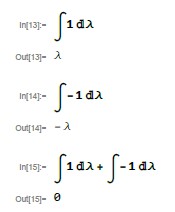 by FrediFizzx » Mon Apr 19, 2021 7:12 am
by FrediFizzx » Mon Apr 19, 2021 7:12 am
This should actually be in a new thread.
Here is the nonsense Bell did in his first paper eq. (2).
 = \int\,d\lambda\,\rho(\lambda)\,A({\bf a}, \lambda)\,B({\bf b}, \lambda))
Then Bell says,

You have two unspecified functions as a product and all we know is that they are +/-1. So, the product is going to be either +1 or -1. Taking lambda =1 and
=1)
we will have,

So, you are averaging a bunch of +1's with a bunch of -1's which of course is equal to zero at infinity. Then we have,
 = \int\,d\lambda\,\rho(\lambda)\,A({\bf a}, \lambda)\,B({\bf b}, \lambda) = 0)
There is one way around this dilemma and that is to do what Joy did. So, Bell was wrong because it is possible!
.
This should actually be in a new thread.
Here is the nonsense Bell did in his first paper eq. (2).
[tex]P({\bf a, b}) = \int\,d\lambda\,\rho(\lambda)\,A({\bf a}, \lambda)\,B({\bf b}, \lambda)[/tex]
Then Bell says,
[img]http://www.sciphysicsforums.com/spfbb1/EPRsims/bell1.jpg[/img]
You have two unspecified functions as a product and all we know is that they are +/-1. So, the product is going to be either +1 or -1. Taking lambda =1 and [tex]\rho(\lambda)=1[/tex] we will have,
[img]http://www.sciphysicsforums.com/spfbb1/EPRsims/bell2.jpg[/img]
So, you are averaging a bunch of +1's with a bunch of -1's which of course is equal to zero at infinity. Then we have,
[tex]P({\bf a, b}) = \int\,d\lambda\,\rho(\lambda)\,A({\bf a}, \lambda)\,B({\bf b}, \lambda) = 0[/tex]
There is one way around this dilemma and that is to do what Joy did. So, Bell was wrong because it is possible!
.
